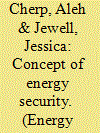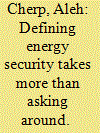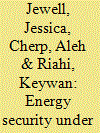| Srl | Item |
| 1 |
ID:
136254


|
|
|
|
|
| Summary/Abstract |
Energy security studies have expanded from their classic beginnings following the 1970s oil crises to encompass various energy sectors and increasingly diverse issues. This viewpoint contributes to the re-examination of the meaning of energy security that has accompanied this expansion. Our starting point is that energy security is an instance of security in general and thus any concept of it should address three questions: “Security for whom?”, “Security for which values?” and “Security from what threats?” We examine an influential approach – the ‘four As of energy security’ (availability, accessibility, affordability, and acceptability) and related literature of energy security – to show it does not address these questions. We subsequently summarize recent insights which propose a different concept of energy security as ‘low vulnerability of vital energy systems’. This approach opens the road for detailed exploration of vulnerabilities as a combination of exposure to risks and resilience and of the links between vital energy systems and critical social functions. The examination of energy security framed by this concept involves several scientific disciplines and provides a useful platform for scholarly analysis and policy learning.
|
|
|
|
|
|
|
|
|
|
|
|
|
|
|
|
| 2 |
ID:
115185


|
|
|
|
|
| Publication |
2012.
|
| Summary/Abstract |
The recent contribution by Benjamin Sovacool proposes 20 dimensions and 320 indicators of energy security in Asia. However, the method for identifying these dimensions and indicators - 64 semi-structured interviews - has three shortcomings. First, Asian policy makers responsible for energy security are absent from the pool of respondents dominated by academics. Second, no prioritization or contextualization of energy security concerns is attempted, leading to an excessively long generic list. Third, no disagreements between the interviewed experts are accounted for. Future attempts to define energy security based on perceptions should involve relevant social actors, include mechanisms for discriminating between primary and secondary concerns and find ways to constructively report on disagreements.
|
|
|
|
|
|
|
|
|
|
|
|
|
|
|
|
| 3 |
ID:
127304


|
|
|
|
|
| Publication |
2014.
|
| Summary/Abstract |
How would a low-carbon energy transformation affect energy security? This paper proposes a framework to evaluate energy security under long-term energy scenarios generated by integrated assessment models. Energy security is defined as low vulnerability of vital energy systems, delineated along geographic and sectoral boundaries. The proposed framework considers vulnerability as a combination of risks associated with inter-regional energy trade and resilience reflected in energy intensity and diversity of energy sources and technologies. We apply this framework to 43 scenarios generated by the MESSAGE model as part of the Global Energy Assessment, including one baseline scenario and 42 'low-carbon' scenarios where the global mean temperature increase is limited to 2°C over the pre-industrial level. By and large, low-carbon scenarios are associated with lower energy trade and higher diversity of energy options, especially in the transport sector. A few risks do emerge under low-carbon scenarios in the latter half of the century. They include potentially high trade in natural gas and hydrogen and low diversity of electricity sources. Trade is typically lower in scenarios which emphasize demand-side policies as well as non-tradable energy sources (nuclear and renewables) while diversity is higher in scenarios which limit the penetration of intermittent renewables.
|
|
|
|
|
|
|
|
|
|
|
|
|
|
|
|